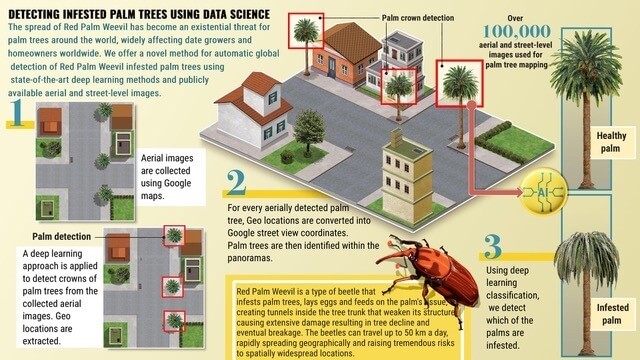The palm weevil beetle destroys trees and palm plantations around the world, which may collapse the attacked trees. Researchers from Ben-Gurion University of the Negev have developed an algorithm, which can be used to detect damage to a tree, based on satellite images and a street view on Google street view - from anywhere around the world

Considering that the palm weevil beetles have traveled across the globe, laid their eggs in trees, caused the collapse of palm trees around the world and damage to date growers, this phenomenon can probably be called an epidemic.
This is a serious phenomenon, since the beetle larvae chew the parts of the tree as they grow and create tunnels inside the trunk, causing the trunk to become more and more hollow over time. These tunnels damage and weaken the trees and even cause them to break and collapse. This beetle, as small as it is, can spread up to 50 kilometers a day, so its early detection is critical. Until now, the only method for identifying the damage to the tree was through a visual and acoustic assessment of individual trees. This is a long and impractical process for large-scale monitoring.
Dr. Michael Pierre from Ben-Gurion University of the Negev and head of the laboratory Data4Good Meet the palm weevil in person. The beetle hit the palm tree in his yard and there was a fear of the tree collapsing. Dr. Pierre discovered that in a small town with many palm trees, the municipality did not have any records of his tree. The municipality did make sure to spray the tree to prevent infections, but the personal case made him think - how can he help the municipality monitor all the palm trees?
In order to solve this problem, Dr. Michael Pierre, Dr. Galit Furman Alpert and PhD student Dima Kagan from the Department of Software Engineering and Information Systems at Ben-Gurion University of the Negev, invented a global monitoring solution. Their findings were recently published inDigital Archive.
Detection of infected trees in Google's street service
Initially, images of streets with palm trees were collected from the Google search engine. Then, they classified the images according to three models: detection of palm trees in aerial images, detection in street images and detection of infected trees. They analyzed more than 100,000 images to build the model and then tested their detection system using images taken from San Diego, California, knowing that trees were affected there in 2016. They were able to find three out of four infected trees reported in the study conducted there and even located trees more infected.
"We were able to develop an algorithm to identify trees attacked by the palm weevil using artificial intelligence and analysis of public information in satellite photos and Google street photos, thereby helping to locate and identify the problem in Israel and around the world," says Dr. Michael Pierre and adds: "Personally, I see what we did as science fiction. It's pretty amazing that you can tell if a beetle has decided to eat a tree on the other side of the world."
At this stage, the algorithm they developed can detect severe and moderate infections in trees and in future development of the algorithm, it will even lead to early identification of the hazard.
More of the topic in Hayadan:
- The start-up company Planetarc-Bio has developed an environmentally friendly preparation against the palm weevil parasite
- the disappearing forest
- The robbed oil palm
- The United Nations is against wildlife trafficking
- CropX will provide NASA with global soil data to improve agricultural crops around the world

3 תגובות
Very very not serious, the researcher (with whom I corresponded) is not aware of the different types of palm, canary - impact from above, can be seen from below, no satellite needed, fruit trees - impact from below, cannot be seen at all. The main question is ease
The publication of such superficial studies in countless scientific websites, as one who has been working in this for 20 years, I am really sad about this article that I have already read on Ynet,
With all due respect to the research, the phenomenon in Israel has been known for 15-20 years. As someone who traveled to Beit Shean for years and saw how the palms bend and wither and no one came (authorities and councils) to cut the trunks and burn them in order to stop the spread of the insect.
As with everything in Israel, much is said and little is done, I guess it is the same in other countries in the world.
Look at what they did years ago in the Baha'i garden. They brought special equipment that embraced the trunk and radiated microwaves, thus killing the insect in its infancy.
very impressive! Hope to work with the Land Surveying Ministry to implement widely in the country. They have access to the latest and best satellite imagery